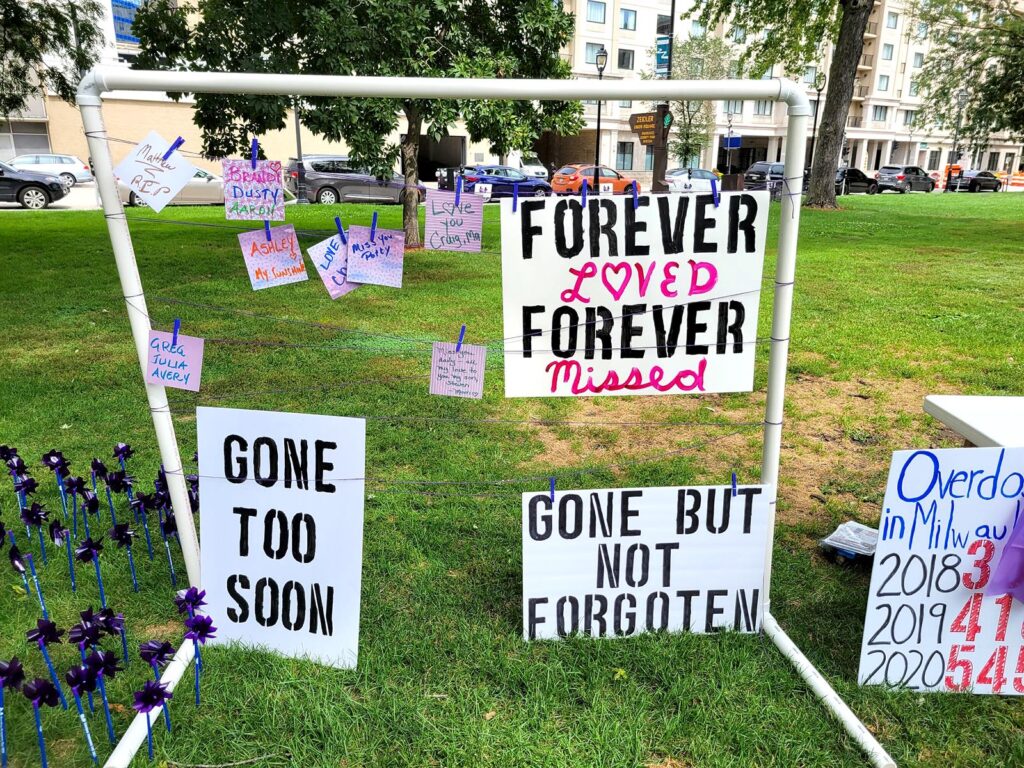Drug Overdose Deaths Still Plague County
Fentanyl driving 5-year rise in Milwaukee, though cocaine also a factor.

Visitors hung notes on a display at the International Overdose Awareness Day memorial event at Zeidler Union Square in downtown Milwaukee last year. Photo by Edgar Mendez/NNS.
As Milwaukee County sees a rise in fentanyl fatalities, cocaine has emerged as a factor in more drug overdose deaths, five years’ worth of data reveals.
The majority of these deaths occurred in the City of Milwaukee.
“Eighty percent of deaths last year involved fentanyl alone or in combination,” said Sara Schreiber, a member of the county overdose team and the forensic technical director of toxicology for the Medical Examiner’s Office. That total has risen steadily over the past four years, based on the Medical Examiner data the team reviewed.
The OD-PHAST project is funded by a grant from the federal Bureau of Justice Assistance through the Comprehensive Opioid, Stimulant, and Substance Abuse Program. The goal of the team is to reduce overdoses in Milwaukee County.
Schreiber said the number of drug overdose deaths that involved fentanyl increased by 170% over that five-year period, while deaths involving heroin decreased 61%.
Cocaine continues to be a factor in more deaths annually. Last year, cocaine was involved in half of the county’s drug overdose deaths, she said. So far this year, cocaine alone or in combination was involved in 60% of deaths. Cocaine was involved in 1,026 deaths from 2017 to 2021.
Fentanyl, alone or in combination, was a factor in 1,526 deaths over that time period. Fentanyl is a synthetic opioid that is 50 to100 times stronger than morphine and is often added to other drugs to increase potency, which also increases the risk of overdose.
The majority of all drug deaths from 2017 to 2021 was classified as accidental overdoses (94%), and most of the victims (93%) were residents of Milwaukee County. In total numbers, most of the individuals were white, but Native Americans had the highest death rate at 136 per 100,000 residents.
The rate of deaths per 100,000 for whites (58.5) and Blacks (55.9) were similar, although Scheiber added that Black people had a higher rate of deaths per resident in 2021 than their white counterparts.
Constance Kostelac, a member of OD-PHAST and director of the Division of Data Surveillance and Informatics at the Medical College of Wisconsin, said during the meeting that there are two full-time social workers housed at the Medical Examiner’s Office to provide outreach to families of drug overdose victims.
“They help people with grief, can connect to treatment or provide other resources,” she said. “They do next of kin interviews as well.”
A disturbing trend
The task force meeting, the first since January, comes at a time when the pace of drug overdose deaths in Milwaukee County is once again at a record level. From Jan. 1 to June 5, there were 210 confirmed drug overdose deaths, with 92 cases pending, according to data provided by Karen Domagalski, operations manager for the Milwaukee County Medical Examiner’s Office.
Assuming all of those cases are confirmed as overdose deaths, a total of 302 easily surpasses last year’s total of 255 during that same period. And the pace doesn’t appear to be slowing. During Memorial Day weekend, the Medical Examiner’s Office investigated 11 probable drug overdose deaths, including six that occurred over a 24-hour period.
The 53206, 53208, 53212, 53214 and 53218 ZIP code areas each lost more than 10 residents to overdoses. The 53215 ZIP code area on the South Side lost the most residents (14) while the city’s hotspot last year, 53204, lost eight residents.
Rafael Mercado, a task force member who works the front lines of the city’s battle against the opioid epidemic on the South Side as the leader of Team HAVOC, pleaded for increased access to treatment during the meeting.
“We try to help people, but we can’t get them in,” he said.
Team HAVOC is a grassroots organization that works to prevent drug addiction and violence. Some of its activities include needle cleanups and Narcan training. Narcan is used in emergencies to stop overdoses.
The problems begin before drug use leads to overdoses.
Mercado explained that a number of steps are needed to receive treatment for substance abuse, each of which presents a barrier to individuals who need urgent help.
“You go through detox, which has a waiting list. Then you get put on a waiting list for treatment. Then if in-patient treatment is needed, you get placed on another waiting list, which could be up to six months,” he said.
Some help could come soon
According to Alderman Michael Murphy, who represents the 10th District and chairs the task force, the first payment to Milwaukee County from a master opioid settlement is expected to occur in late July. The state was awarded $400 million in settlements from three separate opioid distributors last year. The settlement came after Wisconsin and other states filed a federal lawsuit against opioid manufacturers accused of fueling the epidemic.
Seventy-one million dollars will be distributed to Milwaukee County, with around $22 million of that total earmarked for the City of Milwaukee. The funds will be used to support treatment, education and for other resources in the battle against opioids.
Need help for yourself or a loved one?
You can find a comprehensive list of substance abuse treatment services by clicking here.
Record-high pace of drug overdose deaths continues to afflict Milwaukee County was originally published by Milwaukee Neighborhood News Service.
More about the Opioid Crisis
- Co-Chairs Criticize DHS For Lack of Plan, Transparency with Opioid Settlement Funds - Joint Committee on Finance - Oct 21st, 2025
- Opioid Treatment Program Opens First Clinic in Milwaukee - Isiah Holmes - Oct 20th, 2025
- County Executive Crowley, Chairwoman Nicholson Sign Legislation Approving $9 Million for Efforts to Compat the Opioid Crisis - David Crowley - Aug 15th, 2025
- How Are State’s Local Governments Spending Opioid Settlement Payouts? - Addie Costello - Aug 4th, 2025
- MKE County: How County Will Spend $9 Million in Drug Settlement Funds - Graham Kilmer - Jul 29th, 2025
- Milwaukee County Executive David Crowley Announces Over $9 Million for Initiatives to Combat Opioid Epidemic - David Crowley - Jul 17th, 2025
- AG Kaul, 45 Other Attorneys General Plan to Join $720 Million Settlement with Eight Opioid Drug Makers - Wisconsin Department of Justice - Jul 14th, 2025
- Attorney General Kaul Announces Consent Judgment with Kroger Over Opioid Crisis - Wisconsin Department of Justice - Mar 21st, 2025
- Baldwin Votes to Strengthen Penalties, Step Up Enforcement Around Deadly Fentanyl - U.S. Sen. Tammy Baldwin - Mar 17th, 2025
- Wisconsin Communities Get Millions From Opioid Settlement as Deaths Decline - Evan Casey - Mar 1st, 2025
Read more about Opioid Crisis here
Political Contributions Tracker
Displaying political contributions between people mentioned in this story. Learn more.




















